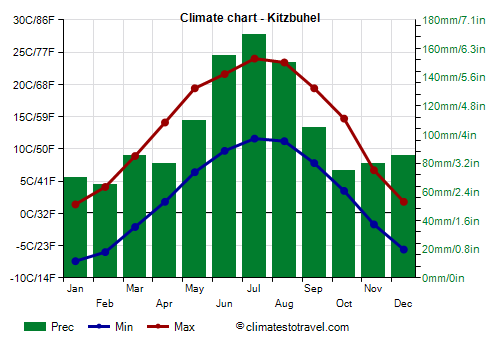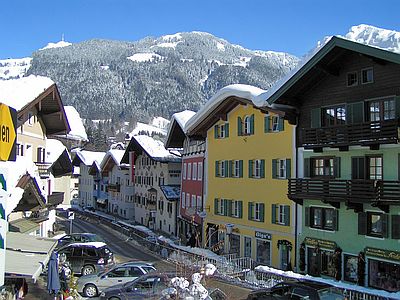Select units of measurement for the temperature and rainfall tables (metric or imperial).
Average weather, temperature, rainfall, sunshine hours

The climate of Kitzbuhel is
moderately continental, characterized by cold winters, with temperatures often below freezing (0 °C or 32 °F), and mild or pleasantly warm summers.
The city is located in Tyrol, in a valley at 750 meters (2,450 feet) above sea level.
Winter is cold and gray. Snowfalls are quite frequent. On average, 205 cm (80 inches) of snow fall per year.
Sometimes there can be cold spells, in which the temperature can drop down to -20 °C (-4 °F) or even below.
In
summer, temperatures are pleasant and suitable for outdoor activities, although sometimes there can be rains and thunderstorms, and it can get very cool at night due to altitude.
Occasionally (but less than in Vienna and in the lowlands), there may be brief hot periods, with highs that can exceed 30 °C (86 °F).
The
average temperature of the coldest month (January) is of -3.2 °C (26 °F), that of the warmest month (July) is of 17.8 °C (64 °F). Here are the average temperatures.
Kitzbuhel - Average temperatures (1981-2020) |
| Month | Min | Max | Mean |
|---|
| January | -7.4 | 1.4 | -3 |
|---|
| February | -6 | 4.1 | -1 |
|---|
| March | -2.1 | 8.9 | 3.4 |
|---|
| April | 1.8 | 14.1 | 8 |
|---|
| May | 6.4 | 19.4 | 12.9 |
|---|
| June | 9.7 | 21.6 | 15.6 |
|---|
| July | 11.6 | 24 | 17.8 |
|---|
| August | 11.2 | 23.4 | 17.3 |
|---|
| September | 7.8 | 19.4 | 13.6 |
|---|
| October | 3.5 | 14.7 | 9.1 |
|---|
| November | -1.7 | 6.7 | 2.5 |
|---|
| December | -5.6 | 1.8 | -1.9 |
|---|
| Year | 2.5 | 13.3 | 7.9 |
|---|
amounts to 1,235 millimeters (48.6 inches) per year: so, it is quite abundant. It ranges from 65 mm (2.6 in) in the driest month (February) to 170 mm (6.7 in) in the wettest (July). The summer is the rainiest season due to afternoon thunderstorms. Here is the average precipitation.
Kitzbuhel - Average precipitation| Month | Days |
|---|
| January | 70 | 10 |
|---|
| February | 65 | 9 |
|---|
| March | 85 | 12 |
|---|
| April | 80 | 12 |
|---|
| May | 110 | 13 |
|---|
| June | 155 | 16 |
|---|
| July | 170 | 15 |
|---|
| August | 150 | 14 |
|---|
| September | 105 | 11 |
|---|
| October | 75 | 9 |
|---|
| November | 80 | 11 |
|---|
| December | 85 | 11 |
|---|
| Year | 1235 | 142 |
|---|
On average, there are around 1,960
sunshine hours per year. Here are the average sunshine hours per day.
Kitzbuhel - Sunshine hours| Month | Average | Total |
|---|
| January | 3.5 | 110 |
|---|
| February | 4.5 | 125 |
|---|
| March | 5 | 150 |
|---|
| April | 5.5 | 160 |
|---|
| May | 6 | 190 |
|---|
| June | 6.5 | 195 |
|---|
| July | 7.5 | 230 |
|---|
| August | 7 | 215 |
|---|
| September | 6 | 185 |
|---|
| October | 5.5 | 175 |
|---|
| November | 4 | 115 |
|---|
| December | 3.5 | 105 |
|---|
| Year | 5.4 | 1955 |
|---|

Best Time
The
best time to visit Kitzbuhel runs from mid-May to mid-September, since it is the warmest and sunniest period of the year. Sometimes, it can be hot in July and August, while in other circumstances, nights can be cool or even a little cold even in these months, so it can be useful to bring a sweatshirt or sweater and a jacket for the evening.